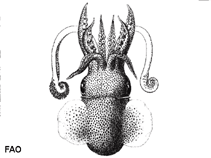Semirossia tenera (Verrill, 1880)
Lesser shining bobtail| Native range | All suitable habitat | Point map | Year 2050 |

|
| This map was computer-generated and has not yet been reviewed. |
| Semirossia tenera AquaMaps Data sources: GBIF OBIS |
Classification / Names Common names | Synonyms | CoL | ITIS | WoRMS
| Sepiida | Sepiolidae | Rossiinae
Environment: milieu / climate zone / depth range / distribution range Écologie
; profondeur 14 - 2622 m (Ref. 104452). Tropical; 78°N - 10°N, 98°W - 126°E
Distribution Pays | Zones FAO | Écosystèmes | Occurrences | Introductions
Arctic, Eastern Central Pacific and Atlantic Ocean: From Nova Scotia to Gulf of Mexico and the Caribbean Sea. Tropical to polar.
Length at first maturity / Taille / Poids / Âge
Maturity: Lm ? range ? - ? cm Max length : 5.0 cm ML mâle / non sexé; (Ref. 1695)
Inhabits muddy and sandy bottoms on the continental shelf and upper continental slope (Ref. 106799). Buries in soft sediments during the day and emerges at night to forage (Ref. 102863).
Life cycle and mating behavior Maturité | Reproduction | Frai | Œufs | Fécondité | Larves
Members of the class Cephalopoda are gonochoric. Male and female adults usually die shortly after spawning and brooding, respectively. Mating behavior: Males perform various displays to attract potential females for copulation. During copulation, male grasp the female and inserts the hectocotylus into the female's mantle cavity where fertilization usually occurs. Life cycle: Embryos hatch into planktonic stage and live for some time before they grow larger and take up a benthic existence as adults.
Référence principale
Références | Coordinateur | Collaborateurs
Jereb, P. and C.F.E. Roper (eds.). 2005. (Ref. 1695)
Statut dans la liste rouge de l'IUCN (Ref. 130435)
Least Concern (LC) ; Date assessed: 29 March 2009
statut CITES (Ref. 108899)
Not Evaluated
CMS (Ref. 116361)
Not Evaluated
Menace pour l'homme
Utilisations par l'homme
Pêcheries: commercial
| FishSource |
Outils
Plus d'informations
Pays
Zones FAO
Écosystèmes
Occurrences
Introductions
Stocks
Écologie
Régime alimentaire
Éléments du régime alimentaire
Zones FAO
Écosystèmes
Occurrences
Introductions
Stocks
Écologie
Régime alimentaire
Éléments du régime alimentaire
Sources Internet
BHL | BOLD Systems | CISTI | DiscoverLife | FAO(Publication : search) | Fishipedia | GenBank (genome, nucleotide) | GloBI | Gomexsi | Google Books | Google Scholar | Google | PubMed | Arbre de Vie | Wikipedia (Go, chercher) | Zoological Record
Estimates based on models
Preferred temperature
(Ref. 115969): 4.8 - 14.4, mean 7.6 (based on 298 cells).
Catégorie de prix
(Ref. 80766):
Unknown.



